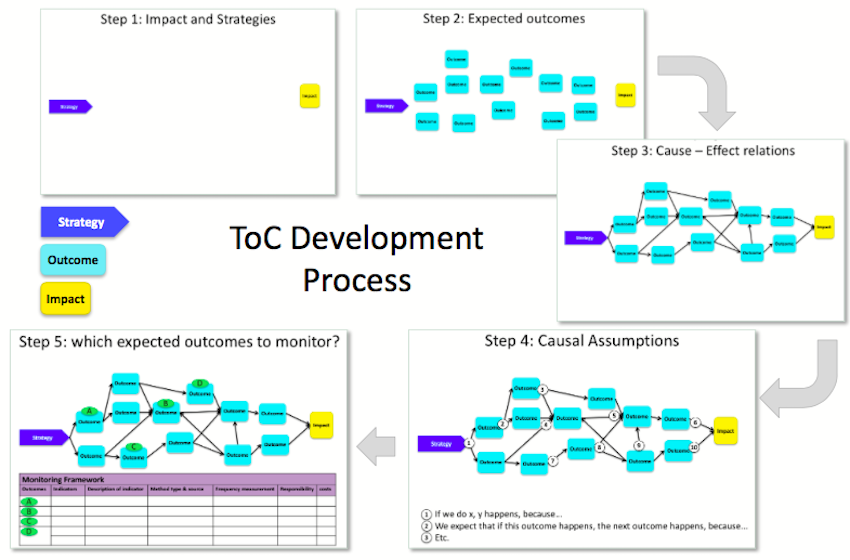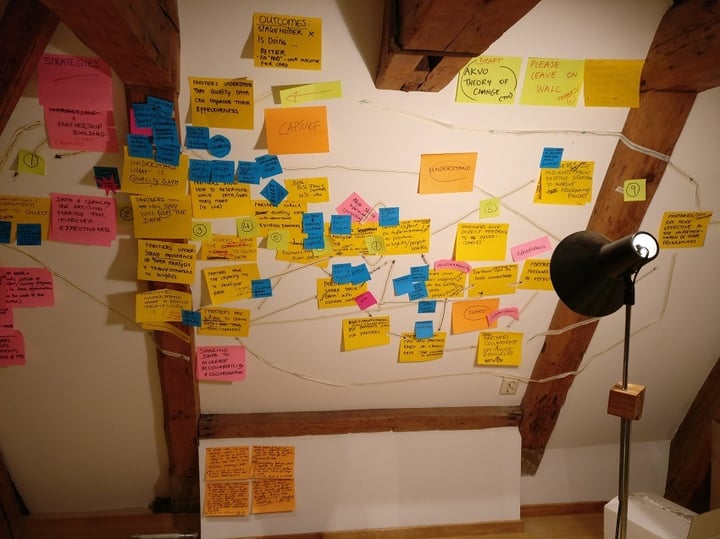This time, change happened from the bottom up: three young Akvonauts – Annabelle, Christien and Geert – went to a planning, monitoring and evaluation (PME) course and came back with the realisation that something needed to change. The course made it clear to them that Akvo monitored key performance indicators at output level [1], but not for outcomes [2] nor for the impact [3] we want to contribute to. As a consequence, we were unable to demonstrate how we support our partners in becoming more effective, accountable and collaborative so that they can achieve lasting and inclusive impact.
The three chartered me, one of Akvo’s planning, monitoring, evaluation and learning (PMEL) specialists, to help them to figure this out using a systemic Theory of Change (ToC) approach. As a result, we have renewed clarity on what Akvo wants to achieve, what we need to do to make that happen, and how we can monitor progress at outcome level.
The Akvo ToC has come a long way in the organisation since those three Akvonauts attended that PME course. It has provided focus and continues to demonstrate how each team plays a key and complementary role in making the outcomes happen. Importantly, the ToC has been instrumental in highlighting that if we want to contribute to our partners’ increased effectiveness, tools are important, but they are not enough. Although Akvo has been providing services next to our tools for a long time, it was not with the clarity of purpose or the level of detail that is now necessary. The ToC made these necessities explicit and inspired us to develop specific services to support our partners in designing their projects so that they can capture and understand reliable data which they can act upon. It has been instrumental in shaping our approach to development and our direction as a rapidly evolving organisation.
In this blog, we’ll explain what a ToC is, describe how our ToC journey took shape, and introduce the Akvo ToC.
What is a Theory of Change?
A Theory of Change consists of two main components: a diagram and a narrative. The diagram visualises how strategies (what we do) connect to expected outcomes (what our partners will do better) and expected impact (improvements at the level of the communities our partners are serving). The narrative explains the causal assumptions: why we believe that “if X happens, then Y happens.” The process of developing a ToC is participatory, so that different perspectives are taken on board, a common understanding of context is gained and co-ownership of the strategies, expected outcomes and impact-focus is generated. With monitoring findings, ToCs are regularly reflected upon and adjusted where necessary.
 Above: A diagram showing the Theory of Change development process.
Above: A diagram showing the Theory of Change development process.
The ToC approach has been around for over ten years [4] and is based on systems thinking. In short, systems thinking can be explained with three key elements:
- Everything is interconnected: every action has an effect; change causes a chain of changes, whether we are aware of them or not.
- Perspective: different people have different perspectives, and all are valuable to understanding the bigger picture.
- Boundary setting/zooming in and out: a piece of reality is intentionally and explicitly chosen to concentrate on, to zoom into. That is the part of reality a project will focus on. But because everything is connected, zooming out to the bigger picture is needed to discover causes of project issues, and effects of project actions, often outside the boundary of the project.
With the development of a Theory of Change, relevant stakeholders zoom out together to look at the bigger picture before zooming into the scope of a programme. With alignment on the expected results, the strategies can be worked out into what concretely needs to be done (activities) to make the expected outcomes happen, and who is best placed to do what. With a ToC which is co-owned by all involved, it is a small step towards deciding which expected results should be monitored, and how.
How did we create Akvo’s Theory of Change?
Before deciding what impact we want to contribute to, and which changes are needed for that to happen, we zoomed out to look at the bigger picture. Which actors do we work with, which problems and opportunities do we see? Once we had mapped out the context, we could define the intended impact: we want our partners to achieve inclusive and sustainable impact.
Then came the more complicated part: making explicit the interconnected outcomes needed to contribute to impact. For us, it’s the improved capacities and performance of our partners. How does what we do help our partners to collect the data they need to monitor progress; to analyse findings so they can make informed management decisions; to share their achievements with a wider audience; and to find actors who are working in the same sector or area?
With the expected outcomes figured out in cause-effect relationships, we could describe the strategies. What does our organisation need to do to make those outcomes happen?
With the very first draft Akvo Theory of Change constructed, we took it to the next phase by including three colleagues from other Akvo offices. In January 2017, we locked ourselves in the Akvo attic to further improve the Theory of Change diagram and formulate the narrative of causal assumptions.

Above: The first draft of Akvo’s Theory of Change. Akvo Amsterdam office. 21 February 2017. Photo by Anita van der Laan.
This second version was shared with several colleagues all over the world for feedback: is it logical, is it complete, do you recognise your team in it? Such feedback rounds are very important to get other peoples’ perspectives and to create shared ownership. All feedback was integrated into the final version, which was presented to and approved by the management team in November 2017.
The Akvo Theory of Change
 Above: Akvo's Theory of Change.
Above: Akvo's Theory of Change.
In short, the Akvo ToC shows that our partners are expected to become more effective for two reasons:
First, because they collect and analyse data to generate insights about the present situation, which they use for decision making.
Partners will have the insights needed to make decisions if they collect, clean, analyse and reflect upon quality data. But they need to know how to collect and analyse data and generate insights, and have the tools to do it efficiently. Before that, they need to know which data they need to collect to make their decisions. If they want to track their programme’s progress, they need to know which results they aim to achieve, which indicators they will monitor, and how they will do that.
Akvo supports partners in the design of their programmes and monitoring frameworks so that when they collect data, they collect the right data. Akvo develops partners’ capacities in collecting, cleaning, analysing and visualising data, and in discovering insights.
The second reason our partners are expected to become more effective is that they communicate their project results and collaborate with other stakeholders.
To be collaborative, optimise resources, and build on the insights of others, organisations need to find new partners and learn from each other’s insights. To do this they need to share their disaggregated data, their project (results) information and their insights, transparently. Akvo supports partners, with tools and services, in sharing data to increase transparency, accountability and collaboration, and to find data of others.
Organisations and governments need well-performing (user-friendly, reliable, scalable, supported, cost-effective, user-driven, future-ready) ICT tools for data collection and analysis, and for sharing. Akvo continuously improves its suite of interconnected tools for data collection, analysis, and sharing.
Where will our Theory of Change take us next?
In the meantime, two of the three original ToC instigators have moved out of the Amsterdam office to East and West Africa, respectively. Both have already started infecting their new teams with their ToC enthusiasm, for example by using the ToC to review and improve the activity overview of a large multi-country programme.
Akvo is a learning organisation, in software development and services. We are therefore preparing to monitor a small selection of expected outcomes so that we can learn about what works, what doesn’t, and why. The Akvo ToC will also be used to facilitate an annual qualitative outcome assessment together with our partners so that we can continue to improve the support we offer to our partners in becoming more effective, collaborative and accountable. Because it is through connecting with our partners that we can contribute to a more inclusive and lasting impact.
Do you want to know more about the Akvo Theory of Change or how to design one for your organisation or programme? Get in touch with us.
Footnotes
[1] An output is the result of our activities, outputs are in our sphere of control.
[2] An outcome is defined as a change in the behaviour, relationships, actions, activities, policies, or practices of an individual, group, community, organisation, or institution. The formulation describes which specific local stakeholder is doing what differently. Outcomes are in our sphere of influence.
[3] An impact is a change at the level of end-users, communities, constituents. Impact is in our sphere of interest, but we can only contribute to it.
[4] Earlier ToCs were called Results Chains. They are also referred to as Intervention Logics. The ToC approach is often compared to the more classic Logical Framework approach. There are three main differences between ToCs and Logical Frameworks, or Logic Models: ToCs zoom into the outcome level to make explicit how we believe change happens; ToCs are meant for programmes where change is not predictable (complex situations), they are flexible and are adjusted regularly; ToCs show and explain cause-effect relations, which are not linear.


